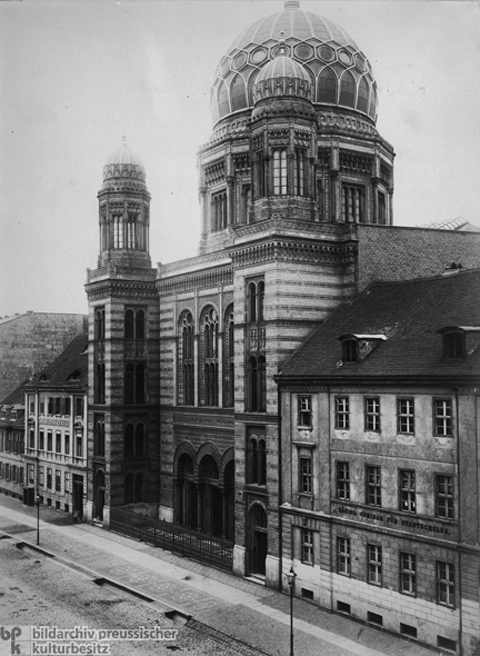













INTRODUCTION | DOCUMENTS | IMAGES | MAPS | EDITOR
|
Just a few days before victorious Prussian troops staged their victory parade through the Brandenburg Gate (September 21, 1866), Bismarck and other Berlin notables attended the dedication of the new Jewish synagogue on Oranienburger Strasse. It was built according to plans by Eduard Knoblauch and Friedrich August Stüler in the years 1859-66. With its huge gilded dome, crowned with a Star of David, the synagogue immediately assumed a commanding place in the Berlin skyline. Just as the Prussians’ victory march symbolized the triumph of German unification under the Hohenzollerns, the dedication of the synagogue marked the emergence of Berlin as a world-class capital and the coming of age of the city’s vibrant Jewish community. Between 1864 and 1874, the Jewish population of Berlin almost doubled, from 24,000 to 45,000. Yet to Berliners and other Germans who resented the Jews’ new-found economic and cultural influence, their alien, “Oriental” character was reflected in the synagogue’s quasi-Moorish architecture, which was intended to evoke the Golden Age of Jewish life in Islamic Spain. Late nineteenth-century historians such as Heinrich von Treitschke and Werner Sombart recognized the strongly urban nature of German Judaism, but they were also among the many Germans who argued that the Jews would always remain true to their nomadic, “Asiatic” origins. Thus, Treitschke’s famous polemic of November 1879, “The Jews are our misfortune,” was preceded by negative comments about Jewish youths crossing the Oder River from Poland, or places further east, to peddle trousers in the streets of Berlin. Treitschke’s mix of bluntness and erudition was a potent brew. He is purported once to have declared that one knows one has entered a city when a synagogue appears. He added on another occasion: “when one considers the characteristic fact that the most beautiful and magnificent house of worship in the German capital is a synagogue – which, naturally, is not a reproach directed to the Jews but the Christians – then one cannot deny that the Jews in Germany are more powerful than they are in any other country in Western Europe.” (Cited in Paul Mendes-Flohr, “The Berlin Jew as Cosmopolitan,” in Berlin Metropolis: Jews and the New Culture, 1890-1918, edited by Emily D. Bilski. Berkeley: University of California Press, 1999, pp. 14-31, here pp. 16, 31.)
© Bildarchiv Preußischer Kulturbesitz |
 print version
print version return to image list
return to image list previous image
previous image
